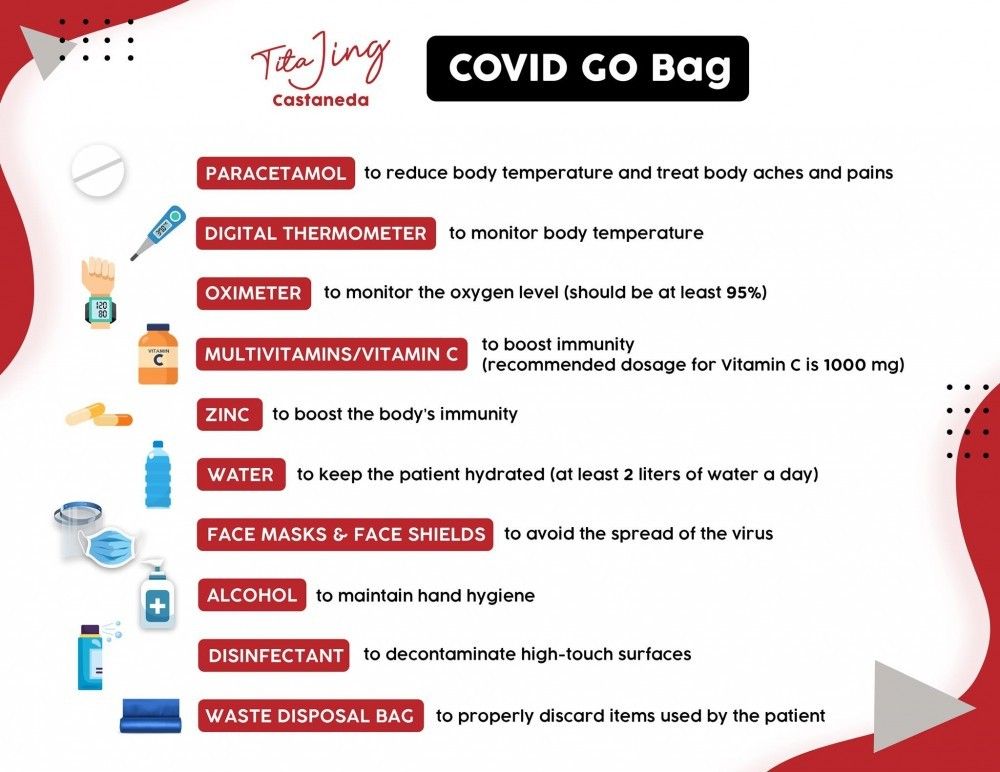COVID-19 Cheat Sheet: What you need to know in 2022 (Part 2)


For the past two years, we have been battling with an invisible and deadly virus that has crippled the entire world. It was in December 2019 when the World Health Organization (WHO) described COVID-19 as a disease caused by a new coronavirus called SARS-CoV-2, with cases of “viral pneumonia” spreading in Wuhan, China.
Information about the virus is therefore critical for us to know what we’re up against and how we can manage its effect. To make it easier for our KasamBuhays, here’s the second part of our “cheat sheet” about COVID-19, based on our interviews with health authorities, medical experts, the Department of Health (DOH) and the World Health Organization (WHO), and my family’s personal experience in 2021 when COVID infected our entire household and my husband was hospitalized due to severe COVID.
Symptoms of COVID-19
- Fever / headache / chills / dizziness / sore throat/ dry cough/ colds
- Body exhaustion or fatigue / Muscle or joint pain
- Loss of taste or smell
- Conjunctivitis
- Different types of skin rash
- Nausea or vomiting / diarrhea
Symptoms of severe COVID?19
- High temperature (above 38 °C)
- Persistent pain in the chest
- Shortness of breath: Some COVID patients have low oxygen levels and this can be very dangerous. Oxygen levels, therefore, have to be monitored through a pulse oximeter. It is placed on your finger as it measures the oxygen saturation in the patient’s blood. Normal oxygen saturation is 95 to 100 percent. The patient will need oxygen assistance for anything lower than this. My husband, Nonong (photo on the left) was rushed to the emergency room when his oxygen level suddenly dropped to 88, with his COVID pneumonia progressing from mild to severe in merely 2 days.
What happens to people with COVID-19?
Based on WHO records, around:
- 80% recover from the disease without hospital treatment.
- 15% become severe and need oxygen assistance.
- 5% become critical which can lead to death. Patients die from COVID due to several reasons—respiratory failure, sepsis, septic shock, thromboembolism, and/or multi-organ failure.
Who is at risk to get severely ill from COVID-19?
Anyone can get severe symptoms of COVID and die from it. However, senior citizens (60 years and up) and people who have comorbidities like high blood pressure, diabetes, obesity, and cardiovascular and respiratory issues are prone to get seriously ill from the virus.
What are the long-term effects of COVID-19?
Several patients who have had COVID continue to experience some of the symptoms like fatigue and shortness of breath. Nonong had severe COVID and it took him 2 months after having been discharged from the hospital before he felt normal. The duration on how long these after effects of COVID-19 persist is still being studied according to WHO.
How to protect yourself from being infected by COVID-19?
- Have yourself vaccinated, whether or not you already had COVID.
- Wear double masks or an N95 or KN95 mask to provide high protection.
- Keep your distance, at least 1 meter from another person whether that person is sick or not. Avoid crowds.
- Wash your hands with antibacterial soap, or sanitize with alcohol.
- Boost your immune system – eat a balanced meal, exercise, take Zinc, Vitamins C, D, E
- Open your window to keep your room well-ventilated.
- Cough or sneeze into a tissue or bent elbow to avoid saliva from spreading.
- Have a COVID-19 Go Bag ready (illustration below)

VACCINATION
Since last year, people around the world have been getting their vaccines against COVID-19. In the Philippines, available vaccines include Pfizer – BioNTech, Moderna, Johnson & Johnson’s Janssen, Sinovac, AstraZeneca, Sinopharm, Gamaleya Sputnik V, and Bharat BioTech.
What is a booster shot?
- an extra dose of vaccine to maintain a longer level of immunity for those who already had their two shots of the original dose of vaccine.
- Interval for getting the booster shot has been shortened by DOH from 6 months to 3 months after the second dose of the primary two-dose vaccine has last been given
Is it okay to do a mix and match or heterologous booster dose of your primary vaccines? According to the Centers for Disease Control and Prevention (CDC), they would rather have the same vaccine brand be used for both the primary and booster vaccines. But the heterologous booster doses (vaccine brand used for booster is different from the vaccine brand used for the two-primary jabs) can still be done but for those 18 years and older.
A study that was also posted by the CDC website showed that any booster brand approved by the FDA, led to a strong antibody response, whatever brand of primary vaccines was used. But if a mix and match or heterologous booster dose was administered, there’s a similar or higher antibody reaction as compared to getting the similar booster brand as your primary vaccines. But just the same, what’s important is what’s available.
DOH guidelines for those who have been infected by COVID and want to get booster shots:
- You should have already been fully vaccinated
- It has been three months since you had your second dose of the primary vaccine of AstraZeneca, Moderna, Pfizer, Sinovac, or Sputnik, or two months since getting one shot of Janssen
- You should have completed the required isolation period:
- Isolation period for probable, asymptomatic, and mild cases – 7 days
- Isolation period for persons with moderate symptoms - 10 days
- Isolation period for persons with severe or critical symptoms and immunocompromised - 21 days
- No fever for the last 24 hours
- Respiratory symptoms have improved
What to expect when getting the vaccine or booster shot for COVID-19?
- Soreness in the area where needle was punctured
- Lethargic / Headache / Muscle and joint pains
- Fever
Not everyone would experience these side-effects but in case you feel any of these, just rest. In my case, I didn’t feel any side- effects during my initial vaccine shots, but I felt feverish and eak during my booster shot. Taking painkillers prior to getting your vaccine is not recommended since the reaction of painkillers to how the vaccine works has not been tested. But you can take paracetamol or mefenamic acid if you will be experiencing some of the side-effects after the jab.
COVID-19 TESTS
When to get tested to find out whether you have COVID-19?
- If you’re feeling any of the symptoms of COVID-19
- If you’ve had a close contact with someone who is COVID-19 positive, have yourself tested on Day 5 to Day 7 after your contact with said person
As you wait for your test results, you should stay at home and keep yourself isolated from your household.
Difference between RT-PCR and Rapid Antigen Test
Polymerase Chain Reaction (PCR) test:
- still the gold standard when it comes to testing for COVID-19
- done by swabbing the throat or nose
- can spot the presence of the virus 48 hours before the COVID-19 symptom starts. Its result can take a while to be released since it has to be done in a laboratory.
Rapid Antigen test:
- Compared to the PCR test, the antigen test is less accurate and can only detect COVID-19 on your body when you’re already infectious. Positive results are usually highly accurate, but false positives sometimes happen. If you are negative on your antigen test, re-testing after 48 hours is advised.
- cheaper than RT-PCR and results can be seen after 15 minutes
- can detect viral proteins by also swabbing the nose or throat.
Difference between Isolation and Quarantine
Quarantine
- when a person has to separate himself from others because he had contact with someone who is COVID-19 positive (whether or not he has COVID-19 symptoms).
- can be done in a facility or at home for 14 days.
Isolation
- when a person needs to separate from others because he/she has COVID-19 symptoms or is positive for COVID-19.
- asymptomatic: isolation for 10 days is advised from the moment you tested positive.
- mild symptoms: can be done at home for 10 days plus 3 days if you are clear from your symptoms.
- severe cases: should be done in a medical facility where the patient can be treated
How long before COVID-19 symptoms develop?
From the moment you got exposed to the virus to the moment the symptoms start is an average of 5-6 days and can be experienced at least for 2 weeks. Although as mentioned earlier, some symptoms linger. That is why people who have been exposed to COVID-19 are asked to stay at home and avoid meeting others for 14 days whether or not they have symptoms to avoid the spread of the virus.
Is there a cure to COVID-19?
There is still no direct treatment for COVID-19 although scientists all over the world are working very hard to develop a cure for it. Oxygen and ventilators are used for optimal support for patients who have severe COVID.
As per WHO, in the United Kingdom’s national clinical trial, Dexamethasone was discovered to have benefits for critically ill patients with COVID-19. Dexamethasone is a corticosteroid that is being used for its anti-inflammatory and immunosuppressant effects.
Another drug that is given to patients 18-years-old and above, with mild and moderate symptoms developing to severe illness due to COVID-19 is Molnupiravir. The drug mutates inside the body into an end product that reduces the reproduction of the virus. However, since this is still considered as a trial drug, this is not yet available in the market due to its serious health risks if taken by the wrong patient or dosage.
Do not self-medicate when you have COVID. Don’t take any medications that are not advised by your doctor. Antibiotics will not cure COVID-19; it doesn’t stop viruses and can only work against infections caused by bacteria.
The Different Variants of COVID-19
During the course of the detection of COVID-19, the virus has mutated and from these continuous mutations, we call the end-result variants. Every time the virus mutates, it changes in terms of transmissibility, severity, ability to be undetected, and ability to evade treatment or vaccine-immunity development.
Scientists all over the world monitor and study these different variants in which they classify as Variants Being Monitored, Variants of Concern, and Variants of Interest. So far, the most known variants and has evidence of increased transmissibility would be the Variants of Concern—Alpha, Beta, Gamma, Delta, and Omicron. According to the DOH, Omicron and Delta are the predominant variants at this time in the Philippines.
- Delta - Preliminary studies show the Delta mutation spreads more easily than other variants and requires further study. It can cause more severe symptoms especially to non-vaccinated patients resulting to hospitalization and sometimes death.
- Omicron - It’s more transmissible than Delta. Preliminary evidence suggests an increased risk of reinfection with this variant, as compared to other variants of concern. So far, symptoms of those infected with Omicron are mild.
No one knows when this pandemic will finally end but until then, we just have to remain vigilant, strong in all aspects, and educated about the changes regarding COVID-19. Let’s not succumb to the uncertainties of the world. Let’s thrive to move forward, grateful for days that are good and finding a silver lining for days that are bad.
--
Watch Pamilya Talk on Facebook, YouTube, and Kumu (@JingCastaneda – 6:00-7:00pm Monday, Tuesday & Wednesday). You can also follow my social media accounts: Instagram, Facebook, YouTube, Twitter, and Kumu. Please share your stories or suggest topics at editorial@jingcastaneda.ph.




















